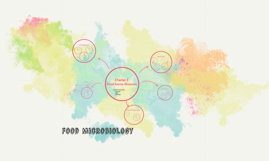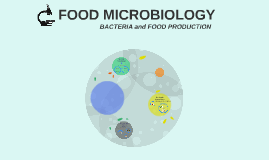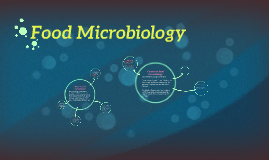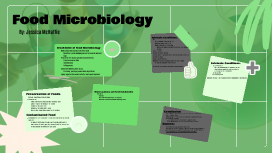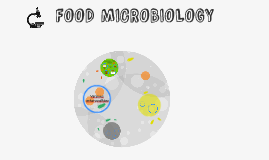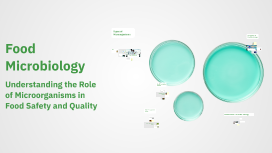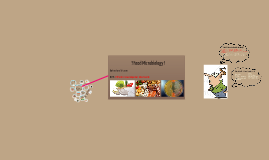Food Microbiology
Transcript: Types of Microorganisms Introduction to Food Microbiology History and Development Food microbiology has evolved since the discovery of microorganisms by Antonie van Leeuwenhoek in the 17th century. Pioneering studies by Louis Pasteur and Robert Koch laid groundwork for understanding food spoilage and safety practices. Importance in Food Safety Introduction to Food Microbiology Microorganisms play a dual role in food safety, as some can cause foodborne diseases while others are essential for fermentation and preservation. Understanding these dynamics is vital to mitigate risks and ensure food safety standards. Viruses Food microbiology examines the role of microorganisms in food processes, impacting safety, quality, and preservation. Understanding these relationships is crucial in preventing foodborne illnesses and enhancing food products. Molds Definition of Food Microbiology Viruses are microscopic pathogens that can contaminate food and cause illnesses. Common examples include Norovirus and Hepatitis A. They can survive on various surfaces, emphasizing the need for stringent hygiene practices in food handling. Molds are multicellular fungi that can both enhance and compromise food quality. They are used in cheese production (e.g., Penicillium) but can also produce mycotoxins leading to food safety concerns. Food microbiology is the study of microorganisms, including bacteria, fungi, and viruses, that inhabit, create, or contaminate food. This field focuses on the interactions between these microorganisms and food products, influencing safety and quality. Yeasts Types of Microorganisms Yeasts are unicellular fungi, primarily known for their role in fermentation. For instance, Saccharomyces cerevisiae is used in bread and alcohol production. While beneficial, some yeasts can cause spoilage, affecting food quality. Microorganisms are essential components of the food ecosystem, influencing food safety, spoilage, and fermentation processes. Understanding the types of microorganisms, including bacteria, yeasts, molds, and viruses, is crucial for effective food microbiology practices. Food Microbiology Bacteria Bacteria are single-celled organisms that play diverse roles in food. They are responsible for both beneficial processes like fermentation and harmful activities such as food spoilage and disease. Examples include Lactobacillus (beneficial) and Salmonella (pathogenic). Food Preservation Methods Chemical Preservatives Chemical preservatives are substances added to foods to prevent spoilage and extend shelf life. Examples include sodium benzoate and potassium sorbate, which inhibit microbial growth while maintaining food safety and integrity, especially in processed foods. Canning Canning is a food preservation technique that involves sealing food in airtight containers and heating them to destroy bacteria, yeasts, and molds. This process allows for long-term storage and nutrient retention, making it a popular method for fruits and vegetables. Food Preservation Methods Understanding the Role of Microorganisms in Food Safety and Quality Pasteurization Food preservation methods play a crucial role in extending the shelf life of food, enhancing safety, and reducing spoilage. Effective techniques such as refrigeration, pasteurization, canning, and chemical preservatives work together to prevent microbial growth and maintain food quality. Pasteurization involves heating food to a specific temperature to kill pathogenic microorganisms. Commonly used for dairy and juices, it effectively reduces spoilage organisms while preserving nutritional value, leading to safer food consumption. Refrigeration and Freezing Refrigeration slows the growth of microorganisms by storing food at temperatures between 32°F and 40°F (0°C to 4°C). Freezing, at 0°F (-18°C) or lower, halts microbial activity entirely, preserving texture and flavor while preventing spoilage for months to years. Role of Microorganisms in Food Future Trends in Food Microbiology Pathogenic Microorganisms Advances in Food Safety Technology Pathogenic microorganisms, such as Salmonella and E. coli, pose significant health risks. These pathogens can contaminate food during production, processing, or handling, leading to foodborne illnesses. Technology-driven solutions like rapid detection systems, blockchain for traceability, and smart packaging are transforming food safety. These innovations help identify contaminants quickly, ensuring quality and reducing foodborne illnesses. Beneficial Microorganisms Impact of Genetic Engineering Certain microorganisms play beneficial roles in food production and preservation. Probiotics, for instance, support gut health, while other beneficial microbes help in the fermentation process, enhancing flavor and nutrition. Microbiome Research in Food Genetic engineering is enhancing food safety by creating resistant crops and modifying microorganisms to eliminate pathogens. These advances contribute to better food quality and






